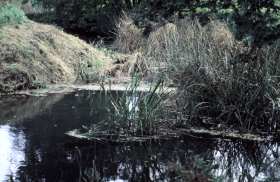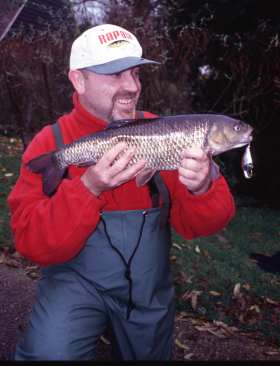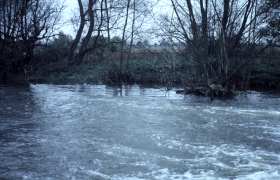Back in 1991 I clocked off work at 4.30 pm after a hard, hotsummer’s day in the fabrication shop. A shower was first on theagenda, followed by a quick bite to eat and then off fishing. As perusual I hand picked half a dozen lures to suit the weatherconditions, slipped them into my waistcoat, grabbed my rod andlanding net and loaded up the car.
I’d spotted a shoal of chub the night before in a large weir poolon the lower River Chelmer and a large head of perch were alsopresent next to the weirs wall and I was dying to have a crack atthem. Consequently I was dreaming about catching one or two the wholeday.
|
|
| |
I arrived at the weir pool at 6.30 pm, moved into the chosen swimand clipped on a Baby Sputterbug (surface lure) in red and white. Nosign of the chub or perch so I assumed they must have moved intodeeper water. But where?
Usually I spot my chub and stalk them but now I was fishing blindand I didn’t have a clue what was going on below the surface. Theliving water was swirling around in the weir pool, and then it hitme, I could be thrashing lures out for a week and would be none thewiser. I’d fallen flat on my face and I wasn’t prepared to get armache, so I packed up and went home.
As I walked through the door Anne-Marie remarked “You’re homeearly”.
“I know.” I said. “Fancy a trip back down to the river?”
“Yes why not?” She replied.
I picked up a note pad and pen and a sinking lure (one foot persecond). We arrived back at the swim around about 7.30 and Iproceeded to draw the shape of the weir pool on my note pad. I thentook off the trebles on the plug and started to plumb the depth. Thistook me by surprise because what I thought was there wasn’t, and visaversa.
|
|
| |
So now I had something to go on and it soon became apparent thatthe lures I had chosen in the first place were the right colours forthe water conditions, but wrong in terms of fishing to depth. So bytaking a little time out I had become a lot wiser about theunderwater features.
So it struck me that fishing blind was a whole new ball game and Ihad to have a rethink on everything. So when you do find yourself inthe same situation that I was in, hopefully you’ll stand and assesthe situation and think before that first cast.
Take the time to look beneath the surface
Each year we fish miles of river bank, tossing out those luresleft, right and centre. But do we take the time to find out what’sgoing on under the water’s surface geographically? The main reason weneed to do this is (as opposed to static fishing where the anglerplumbs out only in front of him) we lure anglers rove about all alongthe river. I look at it like this, if it is necessary for a staticfisherman to plumb out his or her swim or an angler afloat to use asonar to look for features to catch fish, then why shouldn’t a lureangler do similar when fishing rivers? I can definitely say thatafter I had built up a good knowledge of the river bed, my catch ratewent up dramatically.
On any virgin water, unless there is a guide or a gillie at handto enlighten you, you should do your home work before even casting alure. At this point I have to say that the intended stretches ofrivers that I wish to fish in the near future, the majority of workis carried out in the closed season which gives me the basis to workon in the forthcoming months, but even when targeting a certainlength of river during the season there is a procedure that Ifollow.
Get an OS map
The first thing we need to get our hands on is a Ordnance SurveyPathfinder map of the local area you intend to fish, which will showin detail the path of the river, lock gates, weirs, etc. You mightfind a lot of information is already available, so try your localwater authority. In my case I have found the best source of knowledgecame from the local narrow boat company who hire out to the generalpublic. Talk to other fisherman fishing the stretches you have inmind or pop down to the local library, you will be surprised whatinformation can be picked up about the area. For instance where millsonce stood is a prime example.
|
|
| |
On deciding which stretch of river you think looks most prolificfor your intended quarry, take the map you have acquired and sketchonto graph paper. Enlarging the sketch of river over several sheetsis advisable to enable you to put down the data in fine detail.
Tackle
To plumb the depth I would recommend a rod between ten and twelvefeet in length. It does not have to be a lure rod and do not worryabout the action of the rod, you just need to get the lure/weight outthere. I prefer to use 8lb monofilament line or a closed weavesinking braid as opposed to a floating braid. The reason is if youuse a floating braid at a distance it will slow up the lure/weight’sdescent in the water and will give you a false reading. If you wishto use a sinking plug, ie, one foot sinking to one second, I wouldrecommend removing the trebles so that you do not get fouled up inany debris or river-bed foliage. It is okay using a sinking plug butonly on very slow moving rivers. The River Chelmer for instance seemsto run in reverse in places so I use this method on certainstretches. Please do not forget to use a trace wire because you stillget pike hitting the plug. If fish do hit your lure from time to timemake a note on your graph paper so you can return at a later date. Itis very easy to get side tracked into fishing at times like this,remember what you are doing will enhance your fishing at a laterdate.
A more accurate reading will be obtained by using a drilled bulletwith a leger-stop on the bottom of the line. This ensures that if thedrilled bullet should get caught up, the stop will come off, enablingyou to retrieve your line. Another point to remember is that byfeeling your way with a solid object as opposed to sonar readings,you are more likely to find features in greater detail.
Test the timing
The decision as to what weight to use should be determined by theflow. The greater the flow the heavier the drilled bullet. Otherwiseyou will find that a light weight in a strong current will just getwashed down river giving you a false reading. To get an idea of thetiming you need to slip on a pair of waders and find an accessiblepart of the river that is clear to a depth of two to three feet.Place a piece of wood marked off in feet allowing six inches to bedriven into the river bed. Drive the wood into the river bed andstand next to the depth marker and time how long it takes the drilledbullet to cover the said distance watching for the line to go slackwhen the weight hits the bottom. So if it takes the bullet one and ahalf seconds to cover three feet, you have a sinking rate of half asecond to one foot.
Start at a designated point, ie, lock gates, fallen trees, etc.Work along the bank every ten feet. On my local stretches I take twolots of readings, one in the summer months and another in the winterperiod when floods occur.
Over the years you will find some stretches stay the same, whereasothers change due to heavy flooding and boat traffic. Having aknowledge of a river means that you will be aware of fish movementsand be one step ahead of the game.













